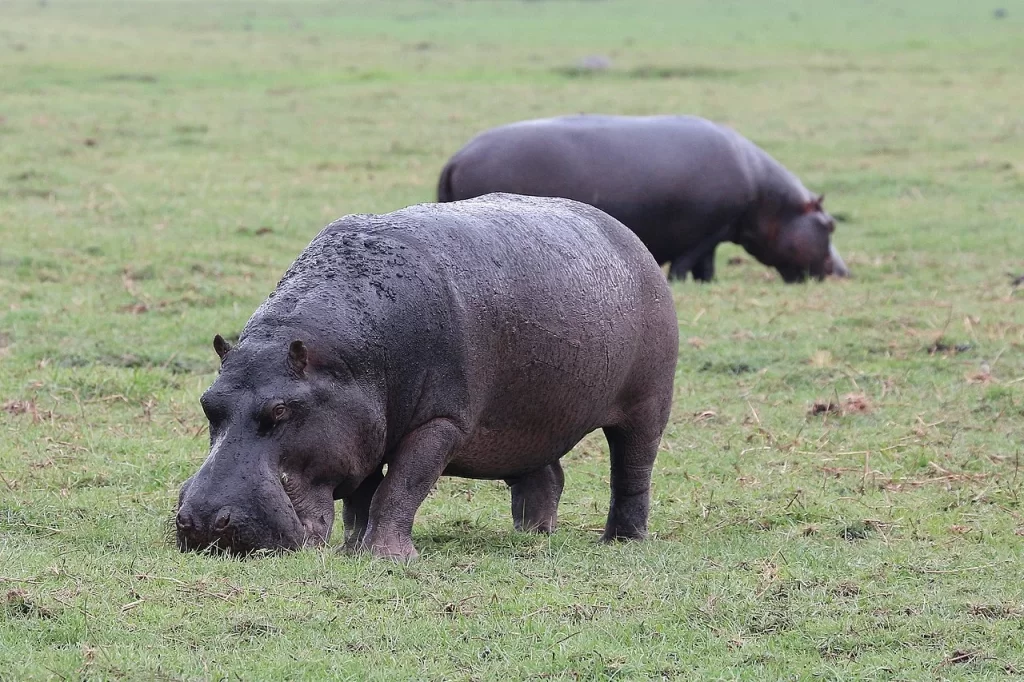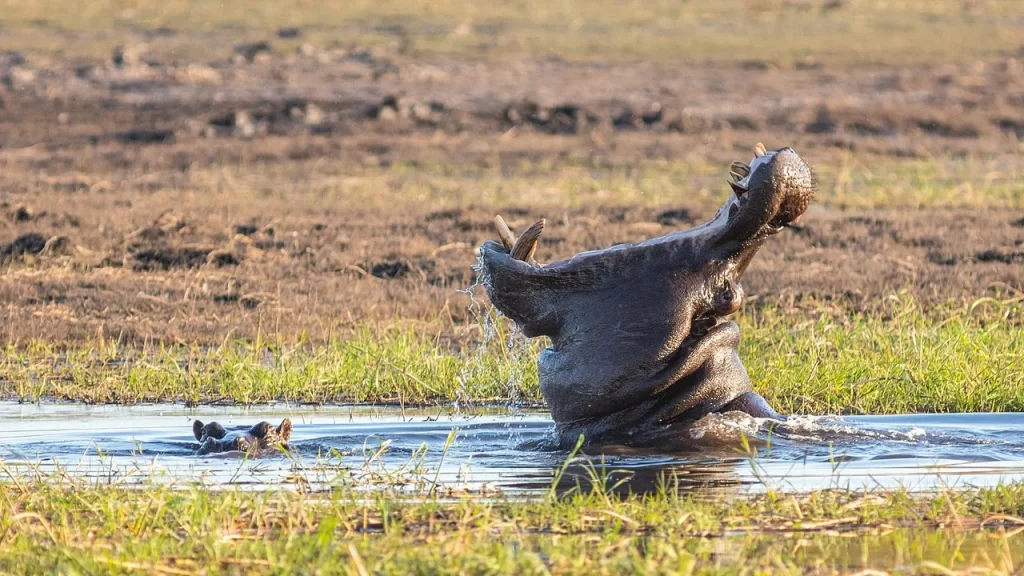Hippos are mostly herbivorous but they are also omnivorous- they eat both animals and plants. They are semi-aquatic- they live mostly in the water but also live on land. They spend most of their time submerged in rivers and lakes, hence the name “water horses”. They require a lot of food to live and maintain their large bodies.
Generally, hippos eat grass, aquatic plants, and fruits. They eat up to 35 kg of grass in one day. They infrequently eat meat. This happens when there is no grass on their feeding lawns. They attack other animals like zebras and wildebeests for prey or steal meat from other predators like hyenas. Due to their large sizes, they can attack and take down their prey successfully.

A hippo weighs between 3000 to 10,000 pounds hence, they need a lot of food to survive. They feed during the night because they are nocturnal. They leave the water in the evening and graze in the area near the water point. Hippos are territorial and they like to be around their habitat. They follow the same path- called a hippo path- every day to go to the same grazing areas called hippo lawns. They go to graze individually or in groups and do so for almost 6 hours every night.
Their strong sense of smell enables them to track down food from a long distance. Their muscular lips also allow them to pull up food from the ground and clutch their prey tightly.
They can travel for up to 10 km to get food but they prefer to be around the water points. When the food is short in supply, hippos can store food in their stomachs and go up to 3 weeks without eating.
Where Do Hippos Live? Hippopotamus Habitat
Hippos are found in sub-Saharan Africa. They are found in slow-moving rivers and lakes where they spend most of their time submerged in the water. They are semi-aquatic but they spend more time in the water than on land. They spend up to 16 hours a day in the water and can hold their breath underwater for up to 30 minutes.

With their bodies submerged under the water, their nostrils, eyes, and ears are above the water, which allows them to breathe, see and hear perfectly. Staying out of the water for a very long period can cause dehydration because they do not have sweat glands. They beat the dehydration by exuding a red, thick, oily mucous substance sometimes known as “blood sweat” produced by glands in their skin. This mucous substance does not evaporate and bring about cooling as normal sweat does; it instead forms a protective layer that keeps their skin moist and free from sunburns. It also keeps their skin free of infections like an antibiotic.
Hippos also have a clear membrane that covers their eyes protecting them and allowing them to see underwater clearly. They can also sleep underwater by using a reflex that allows them to resurface and take a breath and go back into the water without having to wake up.
Despite these adaptations, hippos can neither swim nor float in water because of their enormous weight. They move by pushing and walking along the riverbed and following the water movement. This is made possible by their partially webbed toes.
How Many Hippos Are Left In The World?
Hippos were once found around the world but are now only found in the rivers and lakes of sub-Saharan countries like the Democratic Republic of the Congo, Uganda, Tanzania, Kenya, Ethiopia, Somalia, Sudan, Gambia, and South Africa.
They are not an endangered species but they are vulnerable to extinction. There are 115,00 to 150,000 hippos left in the world as of now. Their loss of habitat and high levels of poaching has led to a reduced number. Their meat, skin, and teeth are valuable to humans in the illegal wildlife market. Their meat is a delectable meal in some areas of Central Africa and their teeth are used as a substitute for elephant ivory tusks.
This makes them a species that needs to be protected from extinction. Humans also need to know the value of keeping the hippos safe and stop poaching and killing them.
Do Hippos Attack Humans?
Hippos are considered one of the most dangerous large land animals in Africa. They kill about 500 people per year. They are normally very aggressive towards anything or anyone that comes their way or invades their territory because of their territorial nature.
The discord between hippos and humans occurs when the hippos deviate to land in search of food. The hippos are very aggressive towards humans and can even attack them without any provocation. They mostly attack humans who are in the rivers or lakes in boats. They can be missed while you sail and float by the water and when in water they can easily kill you. They kill by biting with their 20-inch canines, crushing, or drowning in the water.
It is best to avoid coming across a hippopotamus because they get very hostile when a human or even another animal invades their territory.

What Do You Do If A Hippo Attacks You?
When you find yourself in the way of a hippopotamus near a water point, run in the opposite direction. If you are encountered by a hippo on land, find cover because a human being cannot outrun a hippo.
When a hippo chases you, run in a zig-zag or circles since hippos find it hard to change direction because of their heavy weight. Then find something to get between you and the hippo, like a tree, a car, or a large stone. This will slow the hippopotamus down and give you a chance to get away successfully.
Can You Outrun A Hippo?
Hippos are heavy and have stocky legs. They weigh between 6,000 pounds to 10,000 pounds. This makes them the second largest animal after elephants.
Despite their short and heavily built legs, an angry hippo can easily catch up to a running human being. They make average gallops going at an average speed of 45 kilometers per hour on land. They can also gain momentum very easily as they run hence, they can outrun a human being. The only way to trick and slow down a hippo is to run in a zig-zag or circles. Their massive body weight does not allow them to make quick turns direction-wise.
